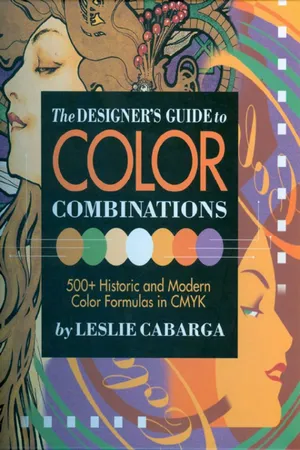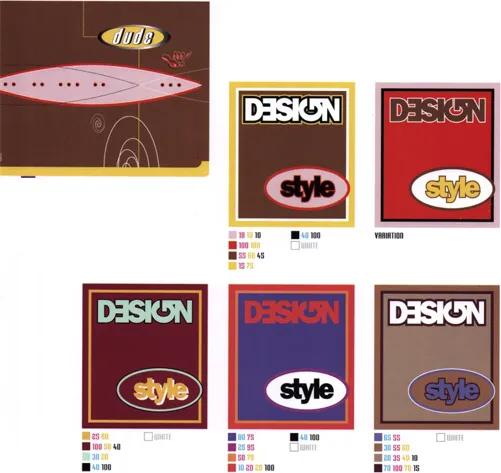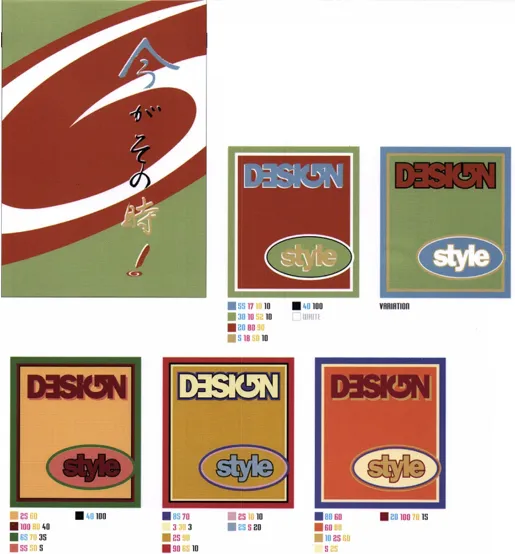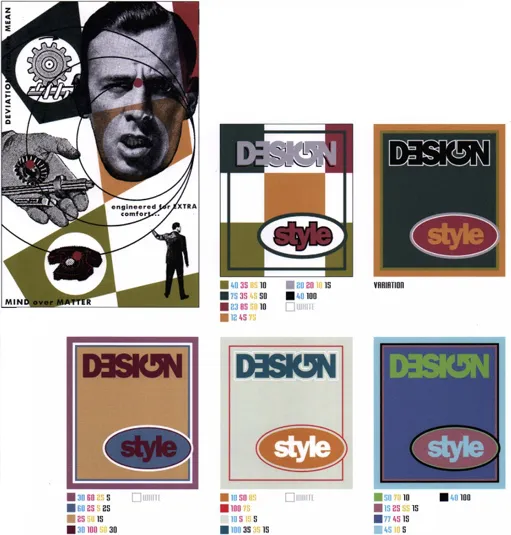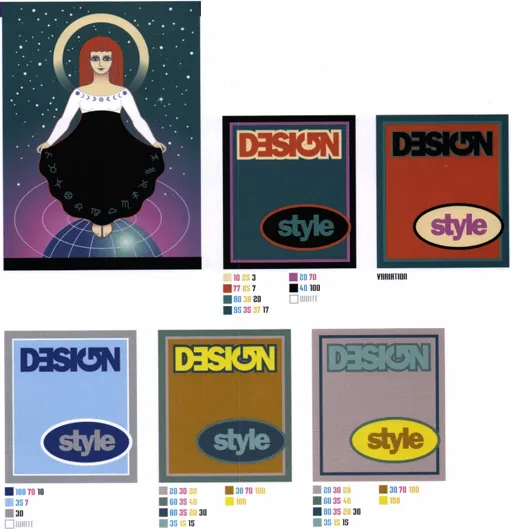![]()
1993
to
2000
Color
What can be said about color at the edge of the millennium except that it continues to follow a trend of trendlessness that began in the rule-breaking period of the late 1960s. Of course, there are still periodic color fads now as there always have been. Often it's the retailers who create them and pray that their predicted color schemes prove popular for the coming season. ♦ The recent tendency toward richly saturated, slightly muddied colors might be considered our current (1999) trend in color. At the same time, however, pure primary comic book colors, various retro color schemes, and fluorescent and metallic colors are equally popular. ♦ In this great age, the arts are beginning to be seen not merely as a sideline to work and family but as an essential ingredient in personal happiness. There is a tendency to place greater importance upon individual creativity, and the computer has provided easy access for many would-be artists. As more artists and designers create, experiment and trash old precepts, the result is a constant evolution of new visual ideas. It's not just microbes that are evolving too fast for science to keep up. ♦ Current styles of design also borrow from past decades, especially from the 1930s, as seen in many of the following examples. Likewise, the new color schemes we see all around us on billboards, magazines and television are not really new at all. What is new is our ability to tweak colors to perfection and inexpensively proof our work until we are satisfied. Years ago, even the top designers had to place a lot of faith in a photoengraver or negative stripper (who was not an artist) and accept the result after one or two proofs. ♦ Fortunately, these times allow tremendous freedom to experiment with all makes and models of color. The rule for current color is, to borrow a 1960s saying, if it feels good, do it.
HEY DUDE, Irina Hogan/designer, Lorna Stovall/creative director, 1997 Expect the unexpected from Backyard, a design studio that doesn't compromise its avant-garde approach when working for a roster of “frontyard” clients. In this self-promotional postcard, the sensual brown background and golden yellow elements contrast with a surprising pink. The color combination does not sacrifice its cool by remaining warm and friendly.
BUS SHELTER POSTER, Lorna Stovall, 1997 To a Western designer's eye, Japanese brush script looks like nothing so much as fun design elements to play with (even more so when compared with our Roman characters). In this cola ad, Stovall has created a dynamite composition with an intriguing color scheme owing a small tip of the hat to the Eastern color sense. The clever addition of the English exclamation point reintroduces the product trademark.
SUPER LEASED LII1ES. Daniel Pelavin, 1997 Illustrator and type designer Pelavin creates graphics on the Macintosh that would have been virtually impossible ten years ago when he (like the rest of us) was bound by pen and ink. With duplication, rotation of his strokes and shapes, and other simple tricks, Pelavin creates intricate designs that can be likened to the decorative steel engravings of one hundred years ago. He is also, obviously, an astute colorist.
HOOVER'S GUIDE, Daniel Pelavin, 1996 It would not be impossible, by hand, to do what this designer does with a computer, but it sure is a lot easier now! Pelavin's created a dimensional highlight effect by simply sliding a copy of the drawing upwards a tad and painting it light yellow. He enjoys capturing the retro look, especially Art Deco, and few do it better. He manages to recreate the color spirit of those times while boldly updating it.
SCIENTIFIC NOTATIONS, Charles S. Anderson Design, 1993 The design world has not yet recovered from Anderson's vision and has instead adopted it. His retro “found art” formula (which reportedly requires many grueling hours of detail work) has certainly found its way into mainstream design consciousness. Anderson's use of color has also been influential. His colors tend toward the industrial: grayed-down, muddy, humorless. Why this should turn out so brilliantly, I can't say.
FROSTONE, Charles S. Anderson Design, 1998 Anderson and designers Jason Schulte and Todd Piper-Hauswirth drew inspiration for this French Paper Company brochure from letterpress technical and ordering forms of the 1940s and 1950s, and the makeready waste sheets that printers use several times over while checking ink levels and registration. This accounts for the purposely overprinted colors and the ordered/disordered look that has become the Anderson trademark.
SNAPPYTOONS, Leslie Cabarga, 1997 Elmo Aardvark, the class.mapic star of the animated screen, is the modern creation of writer, composer and voice artist Will Ryan. In this logo design by the author, Elmo appears exactly as he might have in 1935. All display lettering is hand drawn in a period manner. An interesting color note is the use of a luminous amethyst-like lavender as a type drop shadow against the golden yellow background.
EARTH ANGEL, Leslie Caharga, 1996 The deep vermilion becomes the focal point of this holiday self-promo piece. Since this work is my own, I've decided to take a caption holiday.
LOCAL FLAVORS, Michael Doret, 1998 It takes a master colorist to harmonize so many sultry colors in one illustration. The same gree...
